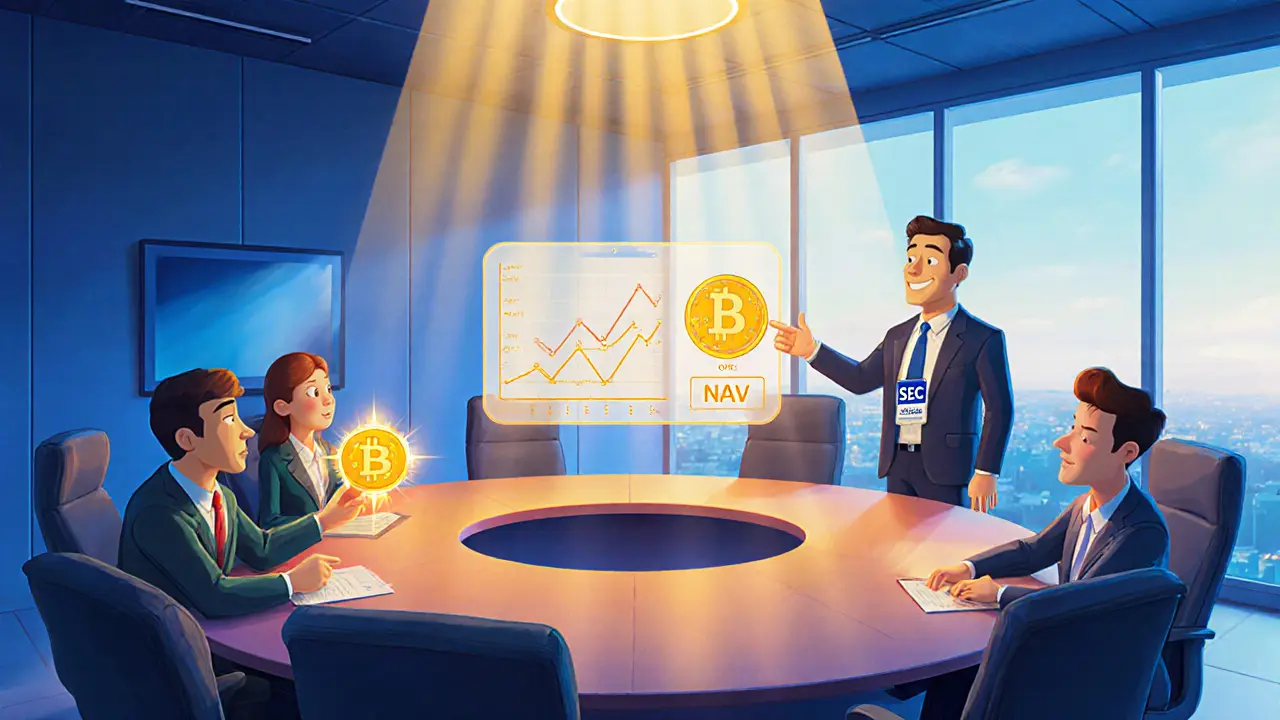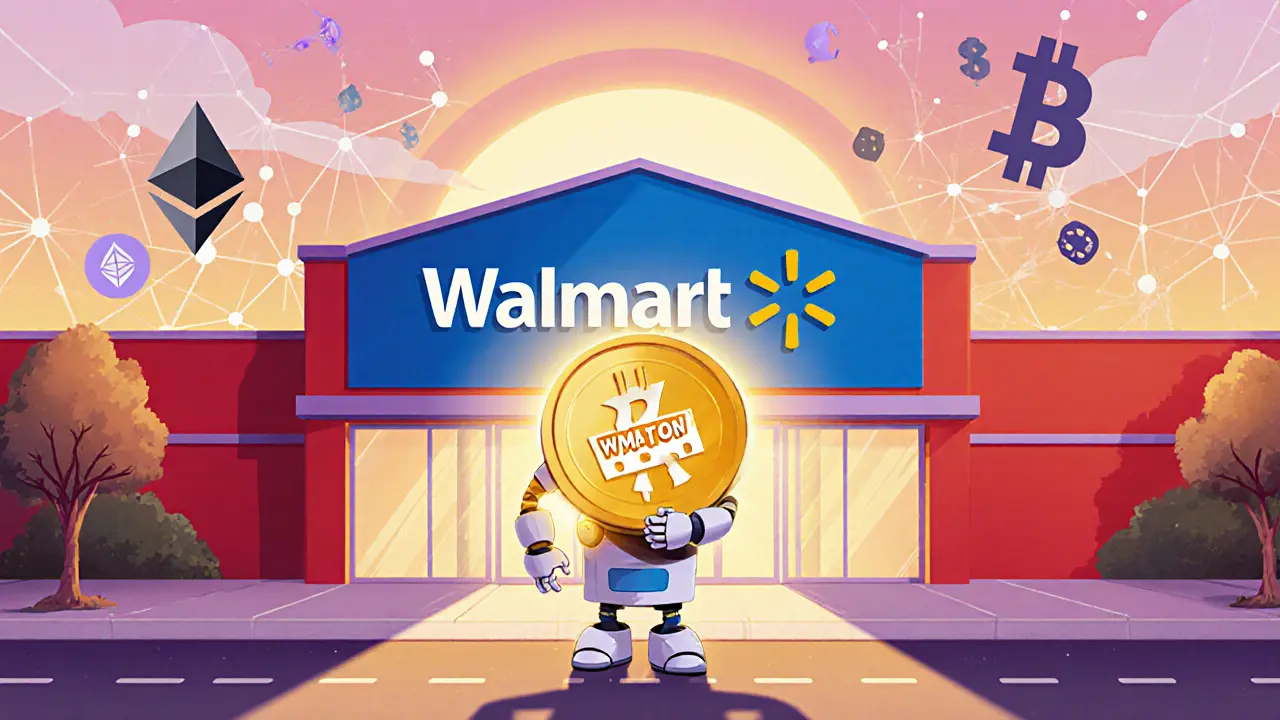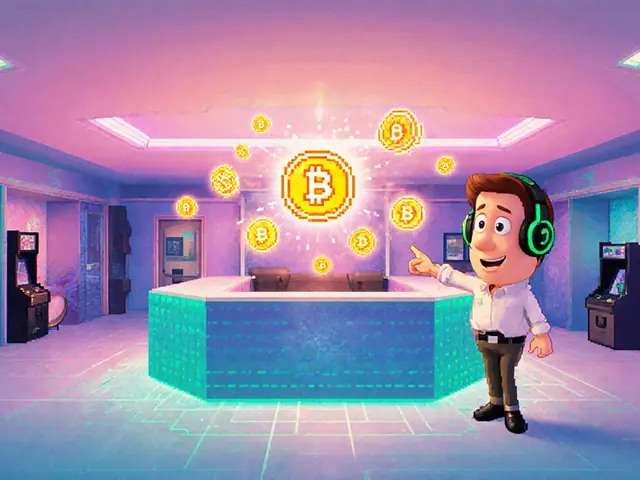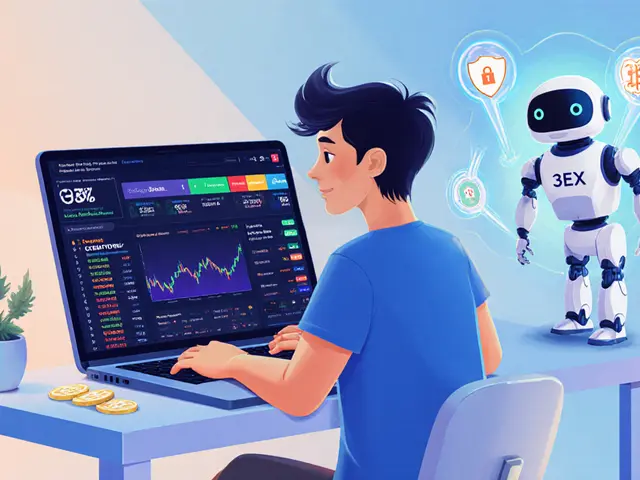WMTon Premium/Discount Calculator
How WMTon Works
WMTon is a tokenized representation of Walmart stock. The Net Asset Value (NAV) represents the current value of the underlying Walmart shares divided by the total token supply. The market price often trades at a premium or discount to this NAV.
WMTon Valuation
Value at NAV:
Value at Market Price:
$0.00
Premium/Discount:
WMTon liquidity is currently low. The market price may differ from NAV due to limited trading volume and gas fee impacts.
Ever wondered how you can own a slice of Walmart without opening a brokerage account? The answer lies in a small ERC‑20 token called WMTon. Below we break down what the token is, how it’s built, why it matters, and the practical steps you need to trade it.
What is Walmart Tokenized Stock (WMTon)?
Walmart Tokenized Stock (WMTon) is a blockchain‑based security token that mirrors the economic performance of Walmart Inc., the world’s largest retailer. Each WMTon represents a fractional claim on an underlying share of Walmart, and any dividends paid by the company are automatically reinvested back into the token, creating a compounding effect for holders.
Who Created It? The Role of Ondo Finance
The token is issued by Ondo Finance, a decentralized finance platform that specializes in bringing real‑world assets (RWA) on‑chain. Ondo’s infrastructure handles custody of the actual Walmart shares, the creation of the ERC‑20 wrapper, and the automated dividend reinvestment logic.
Technical Foundations
WMTon lives primarily on the Ethereum blockchain as an ERC‑20 token, but a secondary deployment exists on the BNB Chain. Both networks use the same token standard, which means any wallet that supports ERC‑20 (MetaMask, Trust Wallet, etc.) can hold WMTon.
The contract address on Ethereum is 0x8210…b9323B, while the BNB Chain address is 0xa7d…3bab4c. The total supply is fixed at 19,685.19 tokens, all of which are already in circulation.
Regulatory Backbone
WMTon is not a utility token; it is classified as a security. The token complies with the U.S. Securities Act Regulation S exemption, which permits non‑U.S. investors to purchase the token without SEC registration. The legal entity that owns the underlying Walmart shares is registered in the British Virgin Islands, a jurisdiction favored for its flexible securities frameworks. Despite the exemption, the token remains under the oversight of the SEC, meaning it must meet standard securities reporting and disclosure requirements.
Economic Mechanics: NAV vs. Market Price
The Net Asset Value (NAV) per WMTon is calculated by dividing the total market value of the held Walmart shares by the token supply. As of October 21, 2025, the NAV sits at $106. The token’s market price on major aggregators (CoinMarketCap, Cryptohopper) hovers around $107‑$108, indicating a modest premium of roughly 1-2% over NAV. This premium can widen or shrink depending on liquidity, gas‑fee swings, and broader crypto market sentiment.
Liquidity Landscape
Liquidity is the Achilles’ heel of most tokenized securities, and WMTon is no exception. The 24‑hour trading volume reported by CoinMarketCap is under $100, while the volume on Cryptohopper spikes to about $109,000 on days of heightened activity. In practical terms, a holder trying to sell a few thousand dollars worth of WMTon may face a noticeable price impact unless they trade on a DEX with sufficient depth.
How to Acquire WMTon
Because the token is not listed on major centralized exchanges, you’ll need a Web3 wallet and a decentralized exchange (DEX) that supports ERC‑20 trading. The typical flow looks like this:
- Install a Web3 wallet (MetaMask, Trust Wallet, etc.) and fund it with ETH or BNB for gas.
- Connect the wallet to a DEX such as Uniswap (Ethereum) or PancakeSwap (BNB Chain).
- Search for the token using the appropriate contract address.
- Swap a portion of your native token (ETH/BNB) for WMTon.
- Verify the token appears in your wallet and check the balance.
Because of the low volume, you may need to set a higher slippage tolerance (e.g., 1‑2%) to ensure the trade goes through.
Pros and Cons - When Does WMTon Make Sense?
Best For:
- Crypto‑savvy investors who already hold ETH/BNB and want exposure to a blue‑chip equity without converting to fiat.
- Residents of jurisdictions where direct purchase of U.S. stocks is restricted or costly.
- Long‑term holders who value the automatic dividend reinvestment feature.
Not Ideal For:
- Traders needing deep liquidity or large position sizes.
- Investors uncomfortable navigating Web3 wallet setups.
- Those who prefer transparent, real‑time pricing directly tied to the underlying stock (e.g., through a broker).
Comparison with Traditional Walmart Stock
| Feature | WMTon (Token) | Walmart Shares (Broker) |
|---|---|---|
| Access Method | Web3 wallet & DEX | Brokerage account |
| Trading Hours | 24/7 on-chain | NYSE hours (9:30‑4 PM ET) |
| Dividend Handling | Automatic reinvestment | Manual claim or cash‑out |
| Liquidity | Low, price impact possible | High, market depth |
| Regulatory Status | Security token (SEC‑overseen) | Standard equity (SEC‑registered) |
| Custody | Ondo Finance custodial pool | Broker‑held or direct registration |

Risk Factors to Keep in Mind
Even though WMTon mirrors Walmart’s stock, the token introduces a layer of blockchain risk:
- Regulatory changes: New SEC rules could tighten the definition of tokenized securities, affecting tradability.
- Smart‑contract bugs: A flaw in the ERC‑20 contract could jeopardize holdings.
- Custodial risk: The underlying shares are held by an offshore entity; any legal dispute could affect the token’s value.
- Liquidity crunch: With only ~20 holders and minimal daily volume, a sudden sell‑off can push the price far below NAV.
Future Outlook
Tokenized securities are still early in their lifecycle. As regulators clarify the legal framework and more institutional players experiment with on‑chain asset custody, products like WMTon could see improved liquidity and tighter spreads to NAV. However, competition from fractional‑share platforms (e.g., Robinhood, eToro) that now offer near‑instant trading and zero‑fee buying could limit the upside for niche tokens that require a Web3 setup.
Quick Takeaways
- WMTon is an ERC‑20 token that gives you economic exposure to Walmart stock.
- Issued by Ondo Finance, it follows a Regulation S exemption and is SEC‑overseen.
- Liquidity is low; expect higher slippage on DEX trades.
- Dividends are auto‑reinvested, giving a compounding benefit.
- Ideal for crypto‑native investors seeking 24/7 exposure, not for high‑volume traders.
Frequently Asked Questions
Can I buy WMTon on a centralized exchange?
No. WMTon is only listed on decentralized exchanges (Uniswap, PancakeSwap). You need a Web3 wallet and some ETH or BNB for gas fees.
How are dividends handled?
Dividends paid by Walmart are collected by Ondo Finance, converted to the token’s native blockchain currency, and automatically reinvested to mint additional WMTon for each holder.
Is WMTon considered a security?
Yes. It is issued under Regulation S and falls under SEC oversight, meaning it is treated as a security token rather than a utility token.
What tax implications does holding WMTon have?
Tax treatment varies by jurisdiction. In many countries the token is taxed like a security, so capital gains, dividend income, and possible withholding taxes apply. Consult a tax professional.
How can I check if WMTon is trading at a premium or discount?
Compare the token’s market price (from CoinMarketCap or your DEX) to its Net Asset Value (NAV). If the price exceeds NAV, it’s at a premium; if it’s lower, it’s at a discount.




24 Comments
Jenna Em
They’re stitching the financial system into the blockchain like a secret tapestry.
Stephen Rees
The way Regulation S is used here feels like a loophole engineered for the crypto elite. It’s as if the SEC handed a back‑door to offshore custodians. Still, the token mirrors Walmart’s performance, so the economics are sound. The real question is who controls the custodial pool.
Katheline Coleman
Allow me to elucidate the salient points concerning this tokenized security. Firstly, the underlying asset – shares of Walmart – is held in a custodial trust domiciled in the British Virgin Islands, thereby satisfying the requirements of Regulation S for non‑U.S. investors. This arrangement mitigates the necessity for SEC registration, yet the token remains subject to periodic reporting obligations under U.S. securities law.
Secondly, the token operates on both Ethereum and BNB Chain as an ERC‑20 asset, affording compatibility with a broad spectrum of wallets such as MetaMask and Trust Wallet. The dual‑chain deployment does not alter the economic exposure; it merely provides alternative avenues for liquidity provision.
The NAV, presently calculated at approximately $106 per token, is derived by dividing the aggregate market value of the held Walmart shares by the fixed supply of 19,685.19 tokens. Market price deviations from NAV, typically in the range of one to two percent, reflect liquidity constraints and prevailing crypto‑market sentiment.
Liquidity, as documented, is a salient limitation. Daily trading volumes under $100 on general aggregators and modest peaks of roughly $109 000 on specialized platforms indicate that sizeable orders may incur perceptible slippage. Consequently, participants should adopt a slippage tolerance of at least one to two percent to guarantee execution.
Dividend treatment is automated; holdings receive proportional dividend allocations, which are immediately reinvested to mint additional tokens. This compounding mechanism is advantageous for long‑term investors, albeit it obscures the immediate cash‑flow benefit derived from traditional dividend payouts.
In summary, the token offers 24/7 on‑chain exposure to a blue‑chip equity, circumventing conventional brokerage constraints, yet it does so at the expense of liquidity and introduces ancillary blockchain‑related risks. Prospective investors must weigh the convenience of tokenized access against the operational frictions inherent to decentralized exchanges.
Amy Kember
Liquidity is thin. You’ll hit slippage. Use limit orders.
Evan Holmes
Low volume, high friction.
Isabelle Filion
Ah, the marvel of tokenizing a retail giant – what could possibly go wrong? One assumes the custodians have better security than a typical broker, yet we all know how flawless offshore trusts are. The premium over NAV is practically a charity donation to the blockchain developers. In any case, enjoy the novelty of paying gas fees to own a slice of Walmart.
Scott McCalman
Wow, this is the most exciting thing since pizza on the blockchain! 🚀🚀🚀 Imagine buying Walmart stock without a broker – pure freedom! 😂
Jessica Pence
Hey folks! Just a heads up – make sure you add the token address manually in your wallet. I once typed a wrong character and spent hours chasing a phantom token. Also, keep an eye on gas fees, they can spike crazy. If you need help, ping me!
Donnie Bolena
Super excited about this! 🎉 It’s awesome to have 24/7 exposure to a stable giant. The auto‑reinvest feature is a sweet bonus! Just remember to set the slippage tolerance so you don’t get stuck. Good luck, everyone!!!
Tom Grimes
Honestly, the whole concept feels like a double‑edged sword. On the one hand, you get the allure of crypto freedom, the romance of decentralized finance, and the promise that your tiny fraction of Walmart will grow over time without you having to lift a finger to claim dividends. On the other hand, you are at the mercy of network congestion, gas price volatility, and the ever‑present specter of smart‑contract bugs that could wipe out your position in an instant. I’d say proceed with caution, keep a diversified portfolio, and never invest more than you can afford to lose, especially in such a thinly traded token.
Joy Garcia
Isn’t it just the perfect recipe for a financial circus? You get the glitter of blockchain, the comforting glow of Walmart’s logo, and the hidden murmur of offshore custodians whispering sweet nothings about security. All while you’re paying gas fees that could buy a whole bag of chips. 🎭
mike ballard
From a market‑microstructure perspective, the token introduces a novel liquidity venue that operates under a continuous double‑auction paradigm, distinct from the discrete batch processing of traditional exchanges. This paradigm shift could, theoretically, flatten the bid‑ask spread over time, but only if sufficient order flow materializes. Right now, the order books are shallow, leading to pronounced price impact for sizable orders.
Molly van der Schee
I hear you all. It’s a brave new world where finance meets code, and it can feel overwhelming. If you take it step by step – set up a wallet, fund it, and test a tiny swap – you’ll get a feel for the process without risking too much. Remember, the underlying asset is still Walmart, so the fundamentals remain.
Erik Shear
Fund wallet. Connect DEX. Swap token. Done.
Tom Glynn
Great rundown! 🌟 If you need any help navigating the Uniswap interface or setting gas limits, just let me know. Happy to walk you through the steps. 👍
Johanna Hegewald
Just a reminder: keep track of the token’s market price versus NAV. It tells you if you’re paying a premium.
Benjamin Debrick
Ah, the elegance of a blockchain‑based equity – a true marvel of modern finance, juxtaposing the antiquated notion of a brick‑and‑mortar retailer with the avant‑garde world of decentralized tokens. One cannot help but applaud the ingenuity of Ondo Finance in bridging this chasm, even if the liquidity remains somewhat… pedestrian. Nevertheless, the prospect of auto‑reinvested dividends is a tantalizing prospect for the astute investor.
john price
Look, the token's price is just a reflection of the market's choppy ride, not a fundamental flaw. If you think the NAV is $106, then any premium is just a short‑term inefficency. Stop overthinking and just hold, or sell if you cant bear the volatility. Dont be a sheep.
PRIYA KUMARI
These so‑called “security tokens” are just a façade for the same old profit‑driven schemes, cloaked in jargon to impress the gullible. The offshore custodians are a red flag, and the low liquidity is a trap for unsuspecting traders. Wake up, people.
johnny garcia
In strict compliance with regulatory frameworks, the issuance of WMTon under Regulation S is a legitimate mechanism to broaden market access for non‑U.S. investors. 😊 However, prudence dictates thorough due diligence regarding custodial arrangements and smart‑contract audits. 📚
Andrew Smith
I think we can all agree that tokenizing real‑world assets is a step forward, but we need better liquidity solutions. Perhaps more liquidity pools or institutional market makers could help. Let’s keep the conversation constructive.
Prerna Sahrawat
Oh, the drama of a retail giant turned crypto token! One can almost hear the chorus of investors sighing in unison as they watch the price wobble like a candle in a storm. The narrative is intoxicating – the promise of 24‑hour trading, the allure of automatic dividend reinvestment, the whisper of offshore custodians hiding in the shadows. Yet, beneath the glitter lies the cold, hard reality of minuscule daily volume, a liquidity crunch that could swallow any sizable order whole. It is a tragic comedy, a ballet of hope and hubris, performed on the decentralized stage. And we, the audience, are left clutching our wallets, questioning whether we are participants or merely spectators in this grand spectacle.
Anna Kammerer
So you want to buy a token that mimics Walmart? Good luck navigating the gas fees while the market decides if it’s worth a cent more than the NAV. 🙃
Mike GLENN
Reading through all these perspectives has been quite enlightening. On one hand, the token offers an innovative bridge between traditional equities and the decentralized finance ecosystem, granting access to a globally recognized retailer without the friction of brokerage accounts. On the other hand, the practical limitations-such as thin liquidity, reliance on off‑chain custodial mechanisms, and exposure to smart‑contract vulnerabilities-cannot be ignored. It is essential for anyone considering an allocation to WMTon to perform a holistic risk assessment, weighing the convenience and potential compounding benefits of automatic dividend reinvestment against the operational complexities and possible regulatory shifts that could affect the token’s tradability. Ultimately, for crypto‑savvy investors with modest exposure and a tolerance for price volatility, WMTon could serve as a complementary holding within a diversified portfolio. For those seeking deep liquidity or immediate price transparency, traditional brokerage routes remain the more prudent choice.